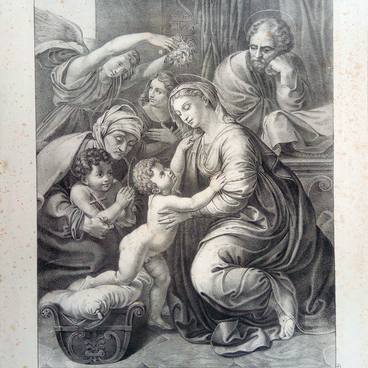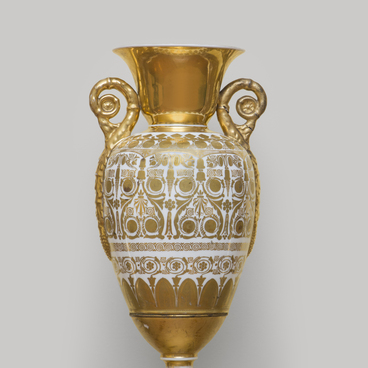The epergne is a three-tiered stand. It was first introduced to Russia in the 19th century. Along with elegant vases and multi-tiered sweet stands, they were used to decorate festive dining tables of the nobles.
Several plates of different diameters with a hole in the center are fixed on a vertical rod and placed one above another like a step pyramid. The correct arrangement of an epergne was the following: candied fruit were placed on the large plate on the lowest level, petits fours (small bite-size cakes) — on the second plate, and sweets — on the smallest plate.
Epergnes were part of big ceremonial services that were produced at the Imperial Porcelain Factory in St. Petersburg. Porcelain sets also included silver, melchior, bronze, and glass items made in Russia or abroad.
In the past centuries, during dinners, guests were tended to by a waiter and an assistant. The assistant laid out delicious desserts on the epergne and the waiter offered them to the guests briefly describing their ingredients and the recipe. Then the waiter put the sweets on plates. The assistant took the plates and handed them to the guests from their right side.
As the time went on, obligatory rules of aristocratic etiquette led to an increase in the variety and number of dishes, as well as to changes in the numbers of courses. Thus, the number of necessary items in dinning sets also increased. Any porcelain store in the 18th and 19th centuries offered customers a variety of items that could be included in a set or used separately. For example: mustard pots, porcelain sets for seasonings and salt, butter dishes, salad bowls, napkin rings, bells, bonbonnieres, jugs and spoons, candlesticks and vases, decorative porcelain centerpieces that were shaped to look like people, houses, churches, flowers and so on. The main decoration of the table could be a beautifully painted large plate, a vinegar bottle or a decanter.
Popular decorative themes painted on tea sets included landscapes, scenes from Greek and Roman mythology, flowers and floral patterns. Traditionally, such sets had a cohesive design and were dedicated to one theme; however, the specific images on each item were often unique. Thus, each item of one set could have different portraits or landscapes depicted on them.
Several plates of different diameters with a hole in the center are fixed on a vertical rod and placed one above another like a step pyramid. The correct arrangement of an epergne was the following: candied fruit were placed on the large plate on the lowest level, petits fours (small bite-size cakes) — on the second plate, and sweets — on the smallest plate.
Epergnes were part of big ceremonial services that were produced at the Imperial Porcelain Factory in St. Petersburg. Porcelain sets also included silver, melchior, bronze, and glass items made in Russia or abroad.
In the past centuries, during dinners, guests were tended to by a waiter and an assistant. The assistant laid out delicious desserts on the epergne and the waiter offered them to the guests briefly describing their ingredients and the recipe. Then the waiter put the sweets on plates. The assistant took the plates and handed them to the guests from their right side.
As the time went on, obligatory rules of aristocratic etiquette led to an increase in the variety and number of dishes, as well as to changes in the numbers of courses. Thus, the number of necessary items in dinning sets also increased. Any porcelain store in the 18th and 19th centuries offered customers a variety of items that could be included in a set or used separately. For example: mustard pots, porcelain sets for seasonings and salt, butter dishes, salad bowls, napkin rings, bells, bonbonnieres, jugs and spoons, candlesticks and vases, decorative porcelain centerpieces that were shaped to look like people, houses, churches, flowers and so on. The main decoration of the table could be a beautifully painted large plate, a vinegar bottle or a decanter.
Popular decorative themes painted on tea sets included landscapes, scenes from Greek and Roman mythology, flowers and floral patterns. Traditionally, such sets had a cohesive design and were dedicated to one theme; however, the specific images on each item were often unique. Thus, each item of one set could have different portraits or landscapes depicted on them.



